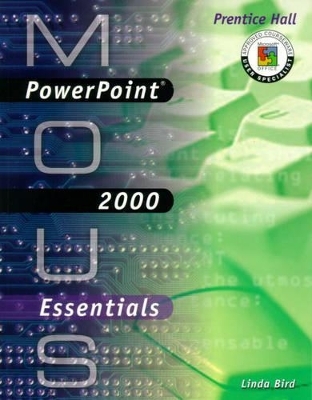
MOUS Essentials
Pearson
978-0-13-019105-2 (ISBN)
- Titel ist leider vergriffen;
keine Neuauflage - Artikel merken
For courses in Microsoft Office 97 and 2000 applications: PowerPoint courseware for the Microsoft Office User Specialist (MOUS) Exam.
MOUS Essentials were created specifically to meet the guidelines established by Microsoft for the Microsoft Office User Specialist (“MOUS”) Program. The authors provide an emphasis on step-by-step tutorials with large screen shots, outstanding student pedagogy, and plenty of exercises. The authors have included a number of new elements designed to help students prepare for the MOUS exams. The MOUS Essentials also include live computer-based training and assessment with Kelly MOUS PinPoint CD-ROM.
LINDA BIRD specializes in corporate training and support through Software Solutions, her own company. She has successfully trained users representing more than 75 businesses, including several Fortune 500 companies, custom designing many of her training materials. Her clients include Appalachian Electric Power Co., Goodyear, Pillsbury, Rockwell, and Shell Chemical. Her background also includes teaching at Averett College and overseeing computer training for a business training organization. Linda has written numerous books on PowerPoint, Word, Excel, Access, and Windows. Additionally, she has written almost 20 instructor's manuals and contributed to books on desktop application programs. She has also penned more than 125 magazine articles and authors monthly how-to columns for Smart Computing magazine. Linda, a graduate of the University of Wisconsin, lives in Gallipolis, Ohio with her husband, Lonnie, and daughters, Rebecca and Sarah. Besides authoring books, Linda home schools her daughters.
1. Getting Started with PowerPoint.
Starting PowerPoint. Creating a Blank Presentation. Exploring the PowerPoint Window. Working with Toolbars and Menus. Using the Office Assistant. Closing Your Presentation and Exiting PowerPoint.
2. Creating Presentations.
Using a Template to Create a Presentation. Creating a Presentation Using the AutoContent Wizard. Navigating Among Different Views. Moving Among Slides in Normal View. Running an Electronic Slide Show. Using the Slide Show Shortcut Keys. Saving Your Presentation. Printing a Presentation.
3. Modifying Presentations.
Opening an Existing Presentation. Adding and Deleting Slides and Changing Slide Layout. Changing Slide Order. Adding, Demoting, and Promoting Text. Copying a Slide from One Presentation into Another. Selecting, Moving and Spell Checking Text.
4. Formatting Text and Bullets.
Changing Text Appearance. Using the Format Painter Changing the Text Alignment and Setting Tabs. Adding and Removing Bullets. Modifying Bullets. Using AutoNumber Bullets.
5. Creating Output.
Adding Speaker Notes. Printing Speaker Notes and Handouts. Previewing a Presentation in Black and White. Using Page Setup. Printing Slides Using a Variety of Formats. Printing a Slide as an Overhead Transparency. Exporting to 35mm Slides.
6. Changing a Presentation's Overall Appearance.
Using Templates. Applying a Template from Another Presentation. Using and Customizing Color Schemes. Changing the Slide Background. Modifying the Slide Master. Inserting a Header and a Footer.
7. Working with Charts.
Selecting an Appropriate Chart Type. Creating a Data Chart. Editing Chart Data. Resizing, Moving and Changing Chart Types. Choosing a Chart Sub-type and Formatting a Chart. Adding Animation to a Chart. Building an Organization Chart. Modifying an Organization Chart.
8. Automating Electronic Slide Shows.
Adding Slide Transitions. Adding Text Animation. Animating Objects. Timing the Slide Show Presentation. Using the Annotation Pen. Using the Meeting Minder.
9. Refining Your Presentation.
Laying Out and Designing Professional-Looking Presentations. Replacing Fonts Automatically. Finding and Replacing Text. Setting Style and Spelling Options. Using the Presentation Assistant to Check Styles and Spelling. Creating a Summary Slide.
10. Using Advanced Multimedia and Graphics.
Locating Clips by Category, Keyword or Style. Previewing and Inserting Pictures. Modifying a Clip Using the Picture Toolbar. Inserting and Playing Sound Clip. Inserting and Playing Motion Clips. Add Animated GIFs.
11. Using Drawn Objects.
Drawing Freehand Objects. Using AutoShapes. Manipulating and Grouping Objects. Formatting Objects with Fill Effects. Formatting Objects with 3D Effects. Formatting Objects with a Shadow Effect. Using WordArt.
12. Sharing Information with Other Programs.
Importing Text from Word. Using the Presentation Assistant to Fix Stylistic Problems. Drawing and Formatting a Table within PowerPoint. Using the Slide Finder to Combine Presentations. Linking an Excel Chart to a PowerPoint Presentation. Embedding a Word Table Within a Presentation. Formatting an Embedded Word Table. Using the Office Clipboard. Exporting an Outline to Word.
13. Creating Interactive Slide Shows.
Creating a Custom Slide Show. Running a Custom Slide Show. Creating Hyperlinks. Using Hyperlinks. Creating Action Buttons. Editing and Removing a Hyperlink. Using Hyperlinks in a Slide Show.
14. Using PowerPoint's Web and Collaboration Features.
Packing Up Your Presentation. Formatting a Presentation for the Web. Using Web Page Preview. Saving a Presentation as a Web Page. Sending a Presentation via E-mail. Scheduling an Online Meeting.
15. Customizing PowerPoint for Your Needs.
Customizing Existing Toolbars. Create a New, Custom Toolbar. Restoring Original Settings.
Appendix A: Using the MOUS PinPoint 2000 Training and Testing Software.
Introduction to PinPoint 2000. Running PinPoint 2000. Installing the Launcher to Your Computer. Preparing to Run the PinPoint 2000 Launcher. Starting the PinPoint 2000 Launcher. Starting PinPoint 2000 Trainers and Evaluations. Running a Trainer. Running an Evaluation. Viewing Reports in the Launcher. Recovering from a Crash During a Trainer or Evaluation. Removing PinPoint 2000.
Appendix B: Preparing for MOUS Certification.
What This Book Offers. Registering for and Taking and the Exam.
Glossary.
Index.
| Erscheint lt. Verlag | 27.6.2000 |
|---|---|
| Sprache | englisch |
| Maße | 218 x 277 mm |
| Gewicht | 904 g |
| Themenwelt | Mathematik / Informatik ► Informatik ► Grafik / Design |
| Informatik ► Office Programme ► Powerpoint | |
| ISBN-10 | 0-13-019105-1 / 0130191051 |
| ISBN-13 | 978-0-13-019105-2 / 9780130191052 |
| Zustand | Neuware |
| Informationen gemäß Produktsicherheitsverordnung (GPSR) | |
| Haben Sie eine Frage zum Produkt? |